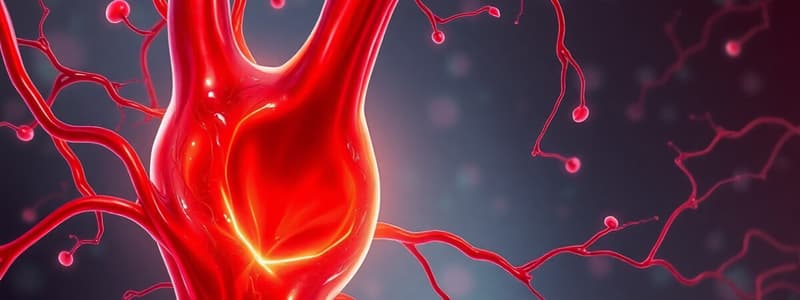Podcast
Questions and Answers
What are the hemodynamic factors that affect venous blood flow?
What are the hemodynamic factors that affect venous blood flow?
Hydrostatic pressure, blood volume, venous compliance, and muscular contractions.
What are the components of hydrostatic pressure?
What are the components of hydrostatic pressure?
The weight of the blood and the pressure exerted by the surrounding tissues.
What forces lead to edema formation?
What forces lead to edema formation?
Increased hydrostatic pressure, decreased oncotic pressure, increased capillary permeability, and lymphatic obstruction.
What changes occur in the venous system at rest and with exercise?
What changes occur in the venous system at rest and with exercise?
Which layer of the vessel wall is the outer layer composed of connective tissue?
Which layer of the vessel wall is the outer layer composed of connective tissue?
What percentage of the body's blood volume do veins hold?
What percentage of the body's blood volume do veins hold?
What are the hemodynamic factors that affect venous blood flow?
What are the hemodynamic factors that affect venous blood flow?
What are the components of hydrostatic pressure?
What are the components of hydrostatic pressure?
What forces lead to edema formation?
What forces lead to edema formation?
What changes occur in the venous system at rest and with exercise?
What changes occur in the venous system at rest and with exercise?
What are the layers of vessel walls?
What are the layers of vessel walls?
How much of the body's blood volume do veins hold?
How much of the body's blood volume do veins hold?
Flashcards are hidden until you start studying
Study Notes
Venous Hemodynamics
- Venous blood flow is influenced by multiple factors.
- Hydrostatic pressure is a major factor in venous hemodynamics, and it's made up of multiple components.
- Edema occurs when the forces pushing fluid out of the capillaries exceed those pushing it back in.
- Venous system changes at rest and during exercise.
Structure of Vessel Walls
- Vessel walls are made up of three layers:
- Adventitia: The outermost layer, composed of connective tissue.
- Media: The middle layer, composed of smooth muscle fibers.
- Intima: The innermost layer, containing endothelium and an elastic membrane.
Venous Capacitance
- Veins hold a significant proportion of the body's blood volume, roughly two-thirds.
- The remaining blood volume is mainly located in the arterial system.
Venous Hemodynamics and Characteristics
- Venous blood flow is influenced by several hemodynamic factors.
- Hydrostatic pressure is a component of venous hemodynamics and is composed of the weight of the column of blood within the vein.
- Edema forms when the forces pushing fluid out of the capillaries exceed the forces pulling fluid back in.
- Venous system undergoes changes at rest and during exercise
- At rest, veins hold a significant portion of the body's blood volume.
- During exercise, venous return increases due to increased muscle activity and the skeletal muscle pump.
- Venous capacitance changes due to contraction and relaxation of smooth muscle fibers in veins.
Vessel Wall Structure
- Blood vessel walls are composed of three layers.
- Adventitia: the outermost layer composed of connective tissue.
- Media: the middle layer composed of smooth muscle fibers.
- Intima: the innermost layer composed of endothelium covering an elastic membrane.
Studying That Suits You
Use AI to generate personalized quizzes and flashcards to suit your learning preferences.




